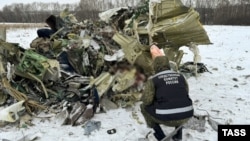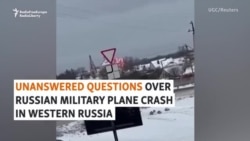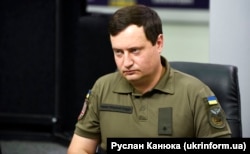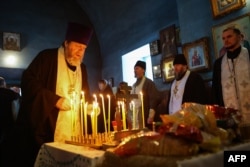Just before the eruption of the spectacular fireball, caught on bystanders’ videos northeast of the Russian border city of Belgorod, a massive military transport plane could be seen veering sharply, then nosediving over the horizon, and into the ground, kicking a plume of orange and black into the gray sky.
It was an Ilyushin Il-76 -- a workhorse plane of the Russian and Ukrainian militaries, known for carrying heavy cargos: tanks, trucks, weapons, equipment, men.
According to the Russian Defense Ministry, however, the jet that crashed on January 24 was carrying 65 Ukrainian prisoners of war who were being transported for a prisoner exchange. The culprit for the downing, the ministry alleged, was Ukraine itself.
The crash was not expected to have a substantial effect on the trajectory of the war in Ukraine. Nearly two years after Russia’s all-out invasion, the battle lines are all but frozen: Ukrainians are digging in and trying to hold on, Russians are pounding their positions with meatgrinder infantry assaults and relentless artillery barrages as lethal drones whine overhead.
If nothing else, it was a potential body blow to Ukrainian morale, which has shown signs of slipping due to a failed counteroffensive and the political infighting in Washington that has deprived Kyiv of desperately needed weaponry.
Here’s what we know so far about the crash of the Il-76.
Nose-Dive To the Ground
First word of the aviation disaster emerged late morning local time on January 24, when the governor of the Belgorod region, which borders Ukraine and which has been repeatedly targeted by Ukrainian missiles and ambush units, announced an “incident” northeast of the city of Belgorod.
Shortly after, around 12:30 p.m. local time, the Russian Defense Ministry announced that an Ilyushin military cargo jet had crashed. The ministry said the plane was carrying 65 Ukrainian prisoners of war, along with a crew of six, and three other people identified as escorts.
Videos began to appear on Telegram showing a plane corkscrewing across the sky and disappearing behind a tree line before an explosion erupts and black smoke billows upward.
By late afternoon, videos on the Russian state news agency TASS and several Telegram channels showed wreckage of a plane scattered across a snowy field.
What Did Ukraine Say?
Shortly after the Russian reports appeared, several Ukrainian news outlets, including Ukrayinska Pravda and RBK-Ukrayina, reported that the plane might have been brought down by a Ukrainian antiaircraft missile. The outlets, however, removed the reports not long after.
The first official word from Ukrainian authorities suggesting some sort of incident came from a military intelligence official, Andriy Yusov, who said an exchange of prisoners between Russia and Ukraine -- a semi-regular occurrence -- had been scheduled for January 24 but was not taking place.
Yusov said officials were investigating the reports of the crash.
Pestered by journalists for comment or confirmation, Ukrainian government authorities declined comment for much of the day.
The military’s general staff issued a statement midafternoon that did not mention the plane crash but asserted Ukraine’s right to target Russian military transport planes in border regions.
“The armed forces of Ukraine will continue to take measures to destroy delivery vehicles and control the airspace to eliminate the terrorist threat,” it said.
By evening, the country’s military intelligence agency released a longer, more detailed statement that confirmed the plane’s crash but said it could not confirm the presence of Ukrainian soldiers on the jet.
The statement insinuated that Russian officials had withheld information about exchanging prisoners, and implied that Moscow had willfully endangered prisoners’ lives.
“This may testify to intentional Russian actions aimed at creating a threat to the lives and safety of prisoners,” the agency, known as HUR, said. “Landing of a transport aircraft in a…combat zone cannot be safe and must in any case be discussed by both sides [in advance], otherwise it endangers the entire process of exchange.”
In his nightly video address, Ukrainian President Volodymyr Zelenskiy called for an international investigation.
“It is clear that the Russians are playing with the lives of Ukrainian prisoners, the feelings of their loved ones, and the emotions of our society,” Zelenskiy said.
So, Were 65 Ukrainian POWs Killed?
It’s not yet entirely clear, even though both sides say a prisoner swap was planned.
In its statement, the Russian Defense Ministry said that Ukrainian authorities were “well aware that, in accordance with established practice, Ukrainian servicemen were to be transported by military transport aircraft to Belgorod airfield today for exchange.”
Still, more than 24 hours later, Ukrainian authorities had neither confirmed nor denied that prisoners of war were killed in the crash.
“Currently, there are no signs of the fact that there were so many people on the Il-76 plane, be they citizens of Ukraine or not,” Dmytro Lubinets, the Ukrainian parliament’s main human rights official, said in a post to the social media platform formerly known as Twitter.
Adding further to the murk: a list of Ukrainian soldiers’ names, purporting to be the names of the POWs on the Il-76, was published not long after news of the crash by Margarita Simonyan, the longtime head of the state-controlled TV channel formerly known as Russia Today.
Several of the names on the list, however, matched those of Ukrainian soldiers who had been released in earlier prisoner exchanges.
Also mysterious: videos from the debris-strewn field showed few signs of bodies or human remains.
“Believe me, if there were seven or eight dozen people there, the field would be strewn with corpses and remains of bodies,” Roman Svitan, a Ukrainian aviation expert, told Current Time.
Were There Missiles On the Plane?
In the partially retracted Ukrayinska Pravda report from January 24, Ukrainian officials also said the Ilyushin was carrying S-300 air defense missiles.
Yusov, the military intelligence agency spokesman, repeated that assertion a day later, in comments to RFE/RL’s Ukrainian Service. He also said that there were other Russian military jets in the airspace nearby.
If true, that would potentially provide a partial explanation why the cargo jet could have been targeted by Ukrainian forces.
“Ukraine had the right to fire at these planes, which were carrying missiles in order to use the S-300 on Kharkiv,” another aviation expert, Valeriy Romanenko, said.
The S-300 missile is a long-range, surface-to-air weapon widely used in antiaircraft systems, Russian and Ukrainian.
Yusov also asserted that high-ranking Russian officials had planned to travel on the jet but that Russia’s main intelligence agency, the Federal Security Service (FSB), barred them from boarding.
"Several official VIPs from the military-political representation of the aggressor state were supposed to have been on board. Their names are known and will be named,” he said. “But at the last moment, the FSB actually ordered them not to board and to use other modes of transport.”
He did not provide evidence.
What Does It Mean For The War?
Fundamentally, this changes nothing for the battlefield. Along the nearly 1,200-kilometer front line, both sides are hunkering down, digging into defenses, trenches, and shelters, as the winter freezes the ground and makes major advances harder to pull off.
Ukraine’s widely touted counteroffensive, which kicked off in June, sputtered out late last year. Russian forces have been incrementally advancing near the towns of Avdiyivka and Kupyansk. Both sides are also believed to be trying to replenish unit strength and weapons supplies.
Ukraine has scored a series of dramatic surprise attacks on Russian targets in recent months. They’ve destroyed or severely damaged Russian Black Sea naval ships and related infrastructure in the Crimean ports of Sevastopol and Fedosia.
Last week, Ukraine claimed it had downed an Antonov A-50 reconnaissance plane, a flying command center used to help Russian aircraft locate Ukrainian targets, while flying over the Sea of Azov. There’s been no definitive confirmation of the plane’s destruction, however.
Those attacks, some of which are believed to have utilized Western-supplied cruise missiles and air defense systems, did not fundamentally change the trajectory of the war. But they did bolster Ukrainian morale.
If it is confirmed that Ukraine shot down the Russian cargo jet, and mistakenly killed dozens of Ukrainian POWs, it would undo that.

















